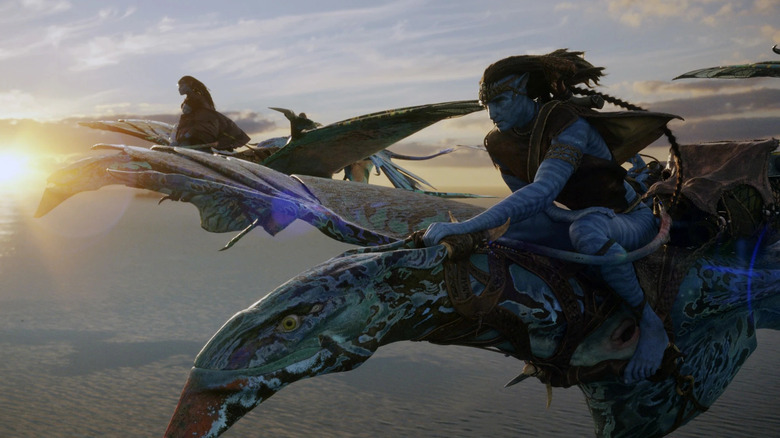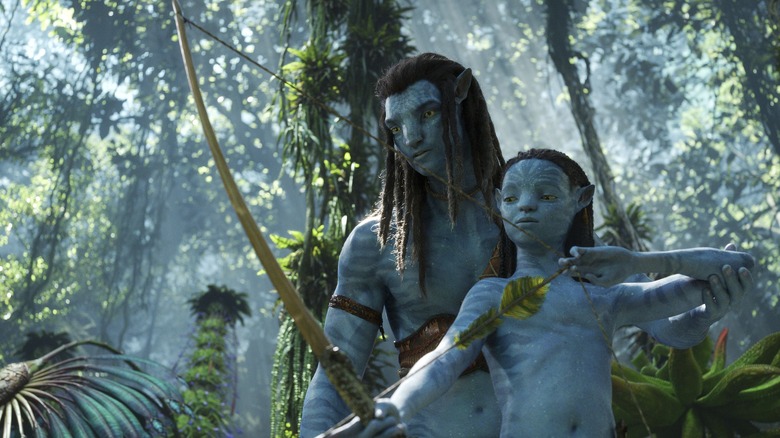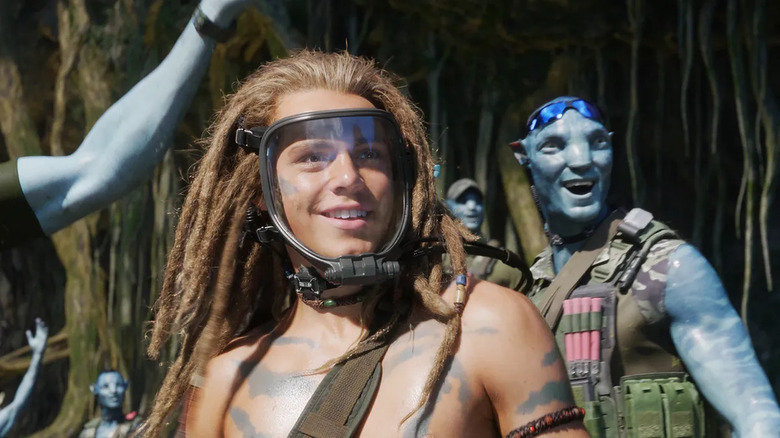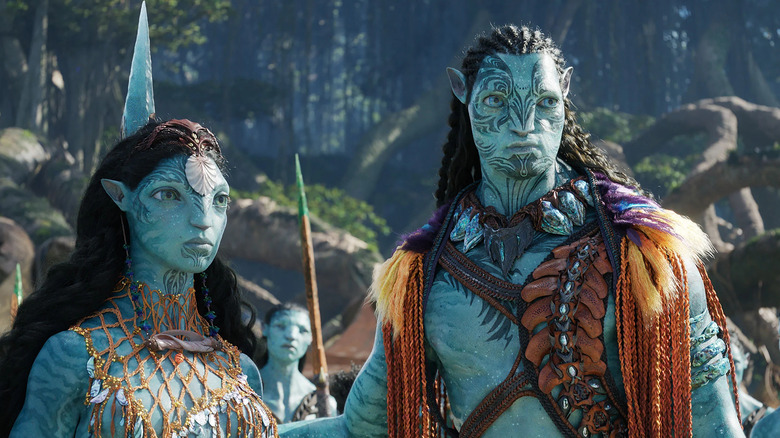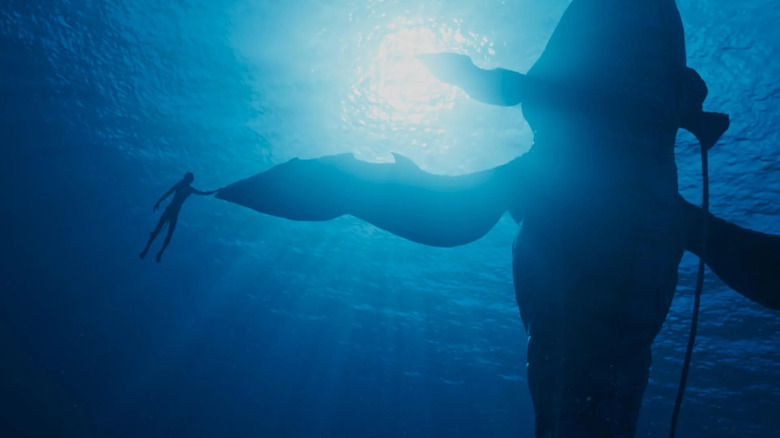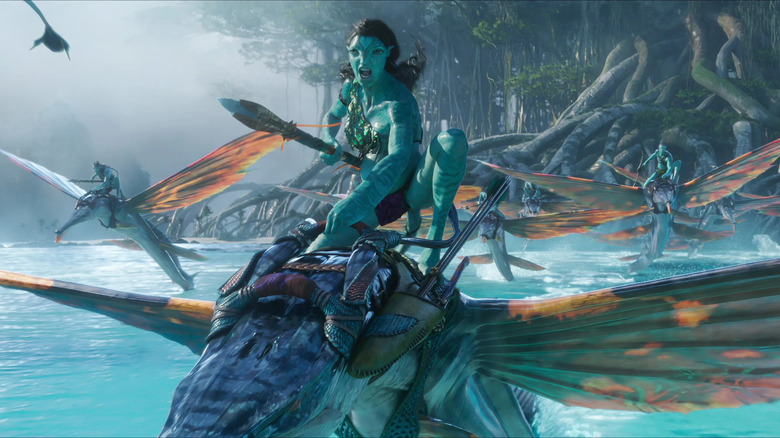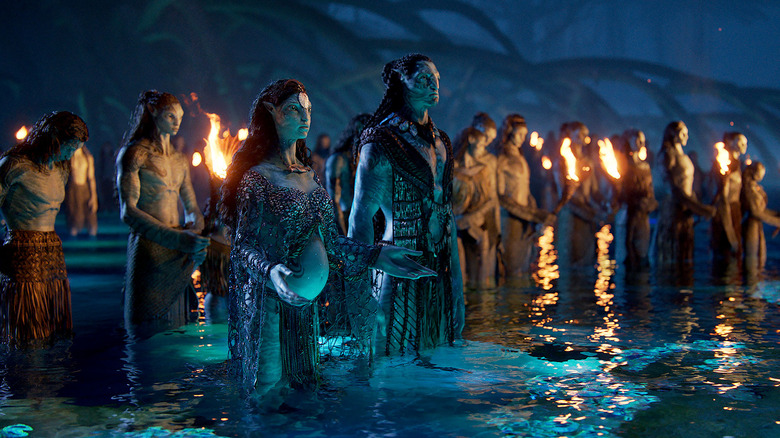Avatar: The Way Of Water Ending Explained: Everything Is Connected
Spoilers for Avatar: The Way of Water follow.
Ever since "Avatar" was released in 2009, creator and director James Cameron has promised (or threatened, depending on one's opinion of the film) that multiple sequels would follow. As the last 13 years rolled on, Cameron's insistence on the sequels coming to fruition began to resemble a boast more than a promise. However, just like George Lucas before him, Cameron was playing the long game when it came to his vision for the future of the planet Pandora and its inhabitants, and the second film (entitled "The Way of Water") has finally arrived.
Yet while Cameron's commitment to the series is now abundantly clear, what exactly will occur in the sequels has remained a mystery prior to the release of the new installment. It's wild to realize in today's landscape of films and shows saturated by previously existing IP, but there are no prior "Avatar" novels, comic books or video games that act as antecedents that could have provided a hint. It's all new territory, something one suspects real-life explorer Cameron prefers.
As "The Way of Water" demonstrates, "Avatar" is about much more than what the first film's critics have referred to as a mere rip-off of "Dances With Wolves," "Ferngully," or "Dune." The new film establishes that this isn't to be a galaxy-spanning saga of numerous planets, but a multi-faceted story about one planet, Pandora, and the struggle for its destiny. "The Way of Water" is a movie about evolution, adaptation, and most of all balance, with its characters realizing their place in larger systems (be it a society or an ecosystem) and understanding that the most profound strength lies within harmony, family, and love.
Growing up with the Sullys
"The Way of Water" begins soon after the end of the first "Avatar," with the now fully Na'vi Jake Sully (Sam Worthington) having achieved the title of Toruk Makto and mated for life with Neytiri (Zoe Saldaña). The couple enjoys a peaceful existence on Pandora while siring several children: Neteyam (Jamie Flatters), Lo'ak (Britain Dalton) and Tuk (Trinity Jo-Li Bliss). In addition, they've adopted the biological daughter of the Na'vi avatar of the deceased Dr. Grace Augustine (Sigourney Weaver), Kiri (also Weaver), whose father is still unknown.
In a montage at the top of the film, Cameron and his co-writers Rick Jaffa and Amanda Silver (along with story contributors Josh Friedman and Shane Salerno) not only catch the audience up with the characters but allow the real-time between the first "Avatar" and this sequel to become a factor in the story, lending a good deal of emotional weight to the Sully family as we the viewers effectively grow up with them.
Quaritch and son
Those emotional stakes are raised higher when humans return to Pandora en masse. Colonel Miles Quaritch (Stephen Lang), who died at the hands of Jake and Neytiri at the end of the first film, has had his consciousness and memories implanted in an avatar body known as a recom (short for recombinant) along with several of his squadmates. Quaritch's new mission, given to him by General Ardmore (Edie Falco), is to seek out Jake Sully and eliminate him, thereby allowing humanity to easily take Pandora by force and colonize it in order to evacuate humans from the dying planet Earth to Pandora.
Quaritch's mission is not going to be so easy, however: it turns out that before his death as a human years earlier, he'd fathered a son, Miles, who was forced to remain on Pandora when the human forces were exiled due to babies not being able to be put into cryosleep. That baby has now grown up into a strong-willed teenage boy called Spider (Jack Champion), and he's considered by the Sullys to be part of their Omatikaya clan.
When the river meets the sea
The interconnected, mixed family of the Sullys becomes even more complex when, upon discovering the existence of Quaritch's recom team, Jake decides that it would be for the good of the larger Omatikaya clan that he give up the title of Toruk Makto and flee with his family to a remote location. That location ends up being the ocean reef village of the Metkayina clan, where Ronal (Kate Winslet) and Tonowari (Cliff Curtis) rule.
As "jungle people" now attempting to become "sea people," the Sullys discover resilience and adaptability that they didn't initially realize they had. They also find their presence in Metkayina village to be disruptive — not in a bad way, but a noticeable one, with their children having ripple effects on the environment around them. Lo'ak not only begins a relationship with Ronal and Tonowari's daughter, Tsireya (Bailey Bass), but also befriends a tulkun (a sentient whale-type creature) named Payakan, who is regarded as an outcast among his people thanks to his attempt to fight back against human insurgents.
Meanwhile, Kiri discovers her relationship with the flora and fauna of Pandora to be mysterious and special. In the jungle, she found wood sprites would collect around her (much like they prophetically did to Jake in the first film), and in the ocean, she can apparently attract and command all sorts of sea life to do her bidding.
The fountain of youth
As the Sullys discover, the Metkayina have a relationship with the tulkun that goes deeper than just respect — the two species consider the other as a sort of extended family, able to speak to each other and share thoughts and feelings. That relationship is threatened by the human hunters who operate on the ocean outside the bounds of Metkayina territory, harpooning and then slaughtering tulkun in order to obtain a substance the creatures contain that's even more precious than Unobtanium, one that stops all human aging.
"Avatar" has the conflict between nature and technology baked into its very premise, and that ambiguity comes from its creator, since Cameron himself isn't so easily defined as either a tree hugger or tech bro. There exists a symbiosis between tech and nature in the film, where technology can do wondrous things like plant a person's mind into the body of an entirely different species, and the more natural way the creatures of Pandora work together involves "bonding" that could be seen as plugging one piece of hardware into another. Yet the temptation to abuse these abilities and powers is always a factor, and Quaritch and the other recoms are a walking, talking example of that.
As such, it's no surprise that Quaritch decides to use the tulkun to draw Sully and his family out of hiding, enlisting the whaling ship The Sea Dragon to start hunting the creatures inside Metkayina waters.
Blood is thicker than water
Using a wounded Payakan as bait, Quaritch successfully captures Lo'ak, Tuk, and Tsireya, drawing Jake and Neytiri as well as the people of Metkayina into battle. The Na'vi are successful in expelling the humans and crippling the Sea Dragon, but in the midst of battle the bonds forged by kinship are strained: during a standoff where Quaritch is threatening to kill Kiri, Neytiri does the same to Spider, driven mad with hate for the recom and love for her adopted daughter.
While neither Kiri nor Spider are murdered, Neteyam catches a bullet and the sinking Sea Dragon threatens to drown Neytiri, Tuk, Jake and Quaritch. Kiri uses her abilities to guide her mother and sister to safety, while Lo'ak proves his courage by helping his father escape death. Spider, feeling the bond of family despite his emotions, helps Quaritch survive, but angrily denies him when the recom asks the child to join him.
Though the Sullys survive through their combined familial strength, their fortress does not emerge intact, as Neteyam succumbs to his wounds. In keeping with the Metkayina's philosophy, the boy's body is given to the ocean, a symbolic gesture of giving back to the environment and the spirits that has thematic roots in the laws of thermodynamics.
The Way of Water
As Tsireya explains to the Sullys, "the way of water connects all things. Before your birth, and after your death." It's a mantra the Metkayina live by, and it's indicative of how the Sullys come to view Pandora and its mother spirit, Eywa, not as a separate entity but one that's inside of a larger system of beings.
Water is a substance that is able to transform into other natural states as well as be pliable — it can evaporate and move into another part of the ecosystem, and it can also form itself to fit any container one places it in. It's a substance so quietly resilient and strong that no less a figure than Bruce Lee has sung its praises, calling it a state of being to strive to emulate.
With "The Way of Water," Cameron and his collaborators have demonstrated that the world of "Avatar" contains a lot of complexity that doesn't require travel to other planets or the appearance of other alien species. It's about the relationship between beings, whether through blood, affection or strife. The drama takes place within one world, teeming with life, as the relationship between technology and nature struggles to find an equilibrium. The intriguing irony is that the "Avatar" movies themselves are environmentally conscious parables that are made with the latest technology money can buy, speaking to how such concepts needn't be mutually exclusive.
As Jake Sully bonds with the Metkayina's Spirit Tree in their underwater cove at the end of the film, he realizes that living in exile, even if it's in peace, isn't enough to stop the encroaching greed of the human forces. The clans must be unified, the violence must cease, the exploiters must be purged, because everything, in the end, is connected.
